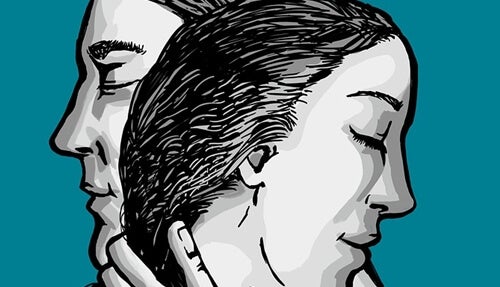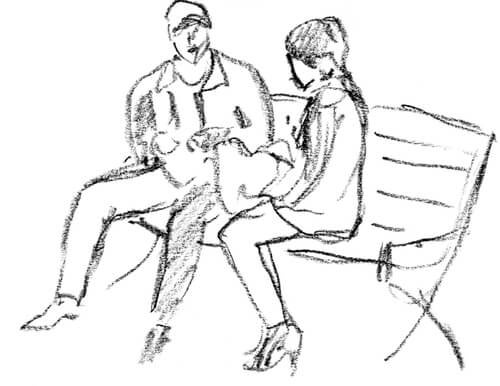The Ultimate Psychology Test for Couples


Written and verified by the psychologist Valeria Sabater
The psychology test for couples is a projective examination. Its goal is to detect the identity and type of bond between two figures. Through this test, you can find out about anxieties, underlying desires or fantasies, and even possible latent conflicts in a relationship, no matter the nature of it (romantic, friendly, familiar, etc.)
This is one of the most interesting projective and complex tools when it comes to evaluating your connection with someone else. It’s not the usual tree drawing or the family drawing test. It’s actually an exercise where the evaluated person must carry out two tasks: they must make a drawing and then create a story.
The data you can get out of this test can be very revealing, as long as you’re honest throughout the whole process. Sometimes, the patient’s age or even the presence of a mental disorder can make it difficult to do it. However, its application is more common in a relationship setting, and that’s why the information it provides is quite interesting in general.

The ultimate psychology test for couples: Objectives, application, and interpretation
Douglas Bernstein created this psychology test for couples in 1964. To design it, he used Machover’s human figure drawing. This tool’s goal was to evaluate concepts such as self-esteem, self-image, personality factors, fears, desires, traumas, etc.
But there’s a concrete reason behind Berstein’s publication of this test. He wanted to have a projective instrument that would help evaluate the relational factor. This way, he would able to analyze how an individual sees and lives their relationship with their significant others.
Therefore, the test studies both conscious and unconscious aspects, because besides making a drawing, this test demands the patient to create a story about the two figures that they portray in that piece of paper.
And this exercise outlines something that defines a good part of our lives: stories. Each person shapes their own reality based on a story that makes sense to them, for better or for worse. Sometimes, it can be real, and other times it can be supported in biased, false, or even invented ideas as a result of some kind of defense mechanism.
What does the psychology relationship test evaluate exactly?
It evaluates dyadic relationships. When carrying out the test, the objective is that the person represents themselves and their relationship with someone who’s important to them.
- The goal is to get to know your own personality traits, as well as the other person’s, and especially the quality of the relationship.
- As we mentioned above, with this test you’d be able to appreciate the conscious and unconscious aspects. Real problems may arise, such as in communicating or showing affection. But you could also discover underlying desires (need for acknowledgment or attention…).
- Children from age seven or older can take it. However, its primary goal is to get to know the quality of a couple’s relationship.
The test’s structure
Let’s go over it in steps:
- The patient is offered a piece of paper and a pencil.
- They must draw two people (without specifying who they are).
- Afterward, the patient must give the two figures a name and age.
- Then, it’s time to write a short story about those two people, in which they express what they think and how they feel.
- Finally, the patient must give the story a title.
Test analysis
The interpretation of this projective test follows three aspects:
Description
- Gender, age, and the link with the evaluated person.
- Realistic or somewhat fantastic image.
- What’s the couple doing? Are they talking, holding hands, etc.? Is there some distance between the two?
Underlying aspects
- Which figure represents the evaluated person? Are they playing a type of role (passive, paternal, maternal, submissive, or avoidant)?
- What are they projecting onto the other person? A need for attention, fear, distance, or desire?
- Is there rejection between the two figures? Is there some kind of contact or communication?
Graphic aspects
- The psychologist must take into account the size of the drawing, the placement of the figures, and the type of tracing (shaky or confident and calm).
- Do the figures have a humanized look or are they cartoon-like? Is there a symbolic or eye-catching feature (deformed or evil-looking)?

Storytelling aspects
- It’s important to identify the type of story. What does it portray? Is the patient happy, needy, or fearful?
- Differentiate aspects that make a reference to reality from those that represent desires or aspirations.
- Coherence throughout the story.
- Context in which the story unravels.
- Title assessment: does it represent the story? What’s the message behind it? Why did the patient choose that title specifically?
To conclude, if you’re wondering about the effectiveness of this test, it’s worth noting that it’s a projective test. These are back-up tools; they’re not useful for a diagnosis on their own. They’re simply a complementary material for other tests and interviews that gather as much information as possible. However, it’s still a very interesting resource that specialists can use to support their examination of a patient.
The psychology test for couples is a projective examination. Its goal is to detect the identity and type of bond between two figures. Through this test, you can find out about anxieties, underlying desires or fantasies, and even possible latent conflicts in a relationship, no matter the nature of it (romantic, friendly, familiar, etc.)
This is one of the most interesting projective and complex tools when it comes to evaluating your connection with someone else. It’s not the usual tree drawing or the family drawing test. It’s actually an exercise where the evaluated person must carry out two tasks: they must make a drawing and then create a story.
The data you can get out of this test can be very revealing, as long as you’re honest throughout the whole process. Sometimes, the patient’s age or even the presence of a mental disorder can make it difficult to do it. However, its application is more common in a relationship setting, and that’s why the information it provides is quite interesting in general.

The ultimate psychology test for couples: Objectives, application, and interpretation
Douglas Bernstein created this psychology test for couples in 1964. To design it, he used Machover’s human figure drawing. This tool’s goal was to evaluate concepts such as self-esteem, self-image, personality factors, fears, desires, traumas, etc.
But there’s a concrete reason behind Berstein’s publication of this test. He wanted to have a projective instrument that would help evaluate the relational factor. This way, he would able to analyze how an individual sees and lives their relationship with their significant others.
Therefore, the test studies both conscious and unconscious aspects, because besides making a drawing, this test demands the patient to create a story about the two figures that they portray in that piece of paper.
And this exercise outlines something that defines a good part of our lives: stories. Each person shapes their own reality based on a story that makes sense to them, for better or for worse. Sometimes, it can be real, and other times it can be supported in biased, false, or even invented ideas as a result of some kind of defense mechanism.
What does the psychology relationship test evaluate exactly?
It evaluates dyadic relationships. When carrying out the test, the objective is that the person represents themselves and their relationship with someone who’s important to them.
- The goal is to get to know your own personality traits, as well as the other person’s, and especially the quality of the relationship.
- As we mentioned above, with this test you’d be able to appreciate the conscious and unconscious aspects. Real problems may arise, such as in communicating or showing affection. But you could also discover underlying desires (need for acknowledgment or attention…).
- Children from age seven or older can take it. However, its primary goal is to get to know the quality of a couple’s relationship.
The test’s structure
Let’s go over it in steps:
- The patient is offered a piece of paper and a pencil.
- They must draw two people (without specifying who they are).
- Afterward, the patient must give the two figures a name and age.
- Then, it’s time to write a short story about those two people, in which they express what they think and how they feel.
- Finally, the patient must give the story a title.
Test analysis
The interpretation of this projective test follows three aspects:
Description
- Gender, age, and the link with the evaluated person.
- Realistic or somewhat fantastic image.
- What’s the couple doing? Are they talking, holding hands, etc.? Is there some distance between the two?
Underlying aspects
- Which figure represents the evaluated person? Are they playing a type of role (passive, paternal, maternal, submissive, or avoidant)?
- What are they projecting onto the other person? A need for attention, fear, distance, or desire?
- Is there rejection between the two figures? Is there some kind of contact or communication?
Graphic aspects
- The psychologist must take into account the size of the drawing, the placement of the figures, and the type of tracing (shaky or confident and calm).
- Do the figures have a humanized look or are they cartoon-like? Is there a symbolic or eye-catching feature (deformed or evil-looking)?

Storytelling aspects
- It’s important to identify the type of story. What does it portray? Is the patient happy, needy, or fearful?
- Differentiate aspects that make a reference to reality from those that represent desires or aspirations.
- Coherence throughout the story.
- Context in which the story unravels.
- Title assessment: does it represent the story? What’s the message behind it? Why did the patient choose that title specifically?
To conclude, if you’re wondering about the effectiveness of this test, it’s worth noting that it’s a projective test. These are back-up tools; they’re not useful for a diagnosis on their own. They’re simply a complementary material for other tests and interviews that gather as much information as possible. However, it’s still a very interesting resource that specialists can use to support their examination of a patient.
This text is provided for informational purposes only and does not replace consultation with a professional. If in doubt, consult your specialist.







